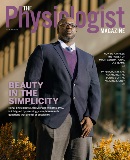Living in the Aura
What life is like after winning the Nobel Prize
by Heather Boerner
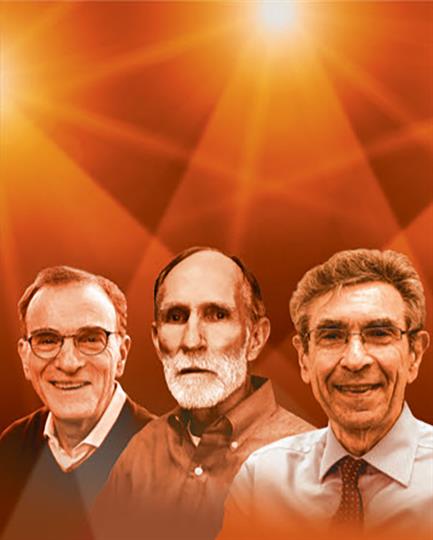
In the decades that Robert Lefkowitz, MD, has been a researcher, he’s known multiple Nobel Prize winners. No matter how familiar he was with them before they received that early-morning call from Sweden, once they were awarded that highest honor
in science, it changed how he saw them. They all share a singular aura, a mystique, says Lefkowitz, the James B. Duke Professor of Medicine at the Duke University School of Medicine and professor of biochemistry and chemistry.
“There were people who were good friends who would then win the Nobel Prize, and from then on I looked at them differently,” he says. “I can’t put it into words, but it was like they were a different species.”
But that, he says, is where the similarities between Nobel laureates end. The prize gives winners the opportunity to pursue anything they wish. For some, it’s the ability to keep doing the research they love or the chance to pursue new fields they may not have been tapped for otherwise. For others, it’s an opportunity to pursue their non-research passions. For all, it’s an opportunity to advocate for a better scientific future.
THE STALWART
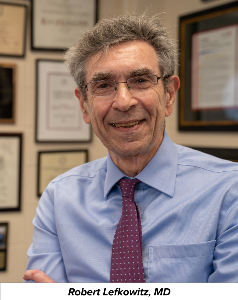 The two months between finding out he’d won the Nobel Prize in Chemistry in September 2012 and accepting it in December are still a blur to Lefkowitz.
The two months between finding out he’d won the Nobel Prize in Chemistry in September 2012 and accepting it in December are still a blur to Lefkowitz.
“Between doing interviews and preparation videos [for the award] and preparing your lecture and preparing to go and making arrangements and who am I going to bring, and the family …” he says. “You can’t see straight.”
Lefkowitz still gets multiple invitations a week to speak, provide a keynote or receive an honorary degree. Today, the wall in his office is plastered not only with the Nobel in a case and the National Medal of Science that President George W. Bush gave
him in 2007, but with a framed Duke University basketball jersey with his name and the number 1—a signifier of Lefkowitz as the university’s first Nobel laureate.
Then there are the honorary degrees from Baylor College of Medicine, Mayo Clinic College of Medicine, University of Camerino in Italy—“They’re from all over the place,” he says.
But mostly, Lefkowitz stays closer to home, speaking to students from elementary through high school, faculty groups, adults, and, especially, undergraduates. “After I won the Nobel, undergrads kind of discovered me,” he says. So he uses the
Nobel aura to inspire the next generation.
“They’re being inspired by somebody who’s doing something socially constructive and by doing science,” he says. “They have this kind of amorphous thing in their head. And then they see somebody in the flesh and blood standing
in front of them doing it, being recognized for it. That’s very, very inspirational.”
Afterward, he says, he’s mobbed for photos and autographs.
And then there’s the Physician Scientist Support Foundation (PSSF), which Lefkowitz founded to encourage more physicians to do research. Physician-scientists have done work “that strongly impacts the way medicine is practiced today,”
he says. But now the number of physicians involved in active research lags at about 1.5 percent, according to PSSF. His foundation is Lefkowitz’s attempt to “right that ship.”
Seven years later, the broad outlines of Lefkowitz’s life remain the same as they were before September 2012. He may arrive at work a little later, and he may not physically conduct experiments, but he still shows up to work every day—even
through those first, blindingly busy two months. He spends his days reviewing data from the lab one-on-one or in small groups. He continues to publish. Now it’s just easier to find collaborators.
The Nobel allowed him to do what he always wanted to do: follow his passions in the lab. “I’ve always felt that whatever I was doing at the moment was the most interesting thing I ever did. That is true right up until this moment,” he
says. “I’m not working on anything right now that I think is going to be my second Nobel Prize. But I love what we’re doing, and I’m excited about it.”
THE PUBLIC EDUCATOR
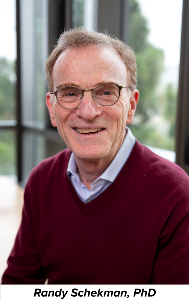 By the time Randy Schekman, PhD, professor of molecular and cell biology at the University of California, Berkeley, got the call that he’d been awarded the Nobel Prize in Physiology or Medicine in 2013, he’d already received a number
of prestigious awards, including the Lasker Award for Basic Medical Research. But nothing could have prepared him for the “shine” that accompanies the Nobel.
By the time Randy Schekman, PhD, professor of molecular and cell biology at the University of California, Berkeley, got the call that he’d been awarded the Nobel Prize in Physiology or Medicine in 2013, he’d already received a number
of prestigious awards, including the Lasker Award for Basic Medical Research. But nothing could have prepared him for the “shine” that accompanies the Nobel.
With other awards, “the glow is relatively short lived,” he says. “With the Nobel, it just never stops.”
From the moment he won the award, he was swept up in invitations, phone calls and “a blizzard of emails” so deep that, in the months following the announcement, he gave up responding to most of them.
Sometimes those invitations came with offers of piles and piles of cash. The week his win was announced, he was invited to a meeting of Nobel laureates in Azerbaijan. The letter said that if he agreed to come, the hosts would “deposit a large sum
of money in your bank account.” And if you showed up? Another large sum would show up.
“It was ridiculous,” he says. “I thought, ‘Oh my god, is this what I can expect?’ And the answer is, more or less, yes.” Schekman declined the offer.
But he did take advantage of the higher profile the prize afforded him. He started by donating the $400,000 Nobel prize money to UC Berkeley to establish the Esther and Wendy Schekman Chair in Basic Cancer Biology. His goal was to highlight the fact that
few of America’s Nobel laureates work at public universities but that those are the universities 70 percent of students attend.
Public education is important to him, so Schekman speaks often about the lack of state funding of public universities. He’s also happy to speak to potential donors whenever UC Berkeley or his undergraduate alma mater, UC Los Angeles, ask him to.
“I grew up in the University of California,” he says. “I’d always been passionate about it. But I didn’t have a soapbox.”
Another passion that he’s been able to express on a larger stage since winning the Nobel is his critique of closed-access corporate journals. Schekman served as editor of the Proceedings of the National Academy of Sciences until 2011, after which
he served as the founding editor for eLife, an open-access journal run and edited by active researchers.
For years, it had bothered him that major publishing companies had taken over scientific publishing, relying on what Schekman believes is a meaningless number: the journal impact factor. Those journals weren’t edited by active research scientists.
And they were keeping research behind a paywall.
So on the same day as his Nobel ceremony in Stockholm, he published an editorial in The Guardian stating he would not publish in Nature, Cell or Science, calling the way that journal impact factors work “toxic” and a “mismeasure of the
value of research.”
Still, research remains his focus. Before he won the Nobel, he had shifted his attention away from the way proteins are secreted by cells to how extracellular vesicles allow the cell to secrete RNA. It’s possible that further research could lead
to liquid biopsies for cancers that often go undetected until they metastasize.
Now Schekman is embarking on a new path. Three years after his wife passed away from Parkinson’s disease, he has agreed to act as the scientific director of ASAP Parkinson’s, a new scientific venture funded by the Sergey Brin Family Foundation
to expand work in the basic science of Parkinson’s.
He won’t be conducting that research himself. But he will help decide which research to fund through the foundation. “This has become my new cause,” he says. “How could I say no?”
THE DIPLOMAT
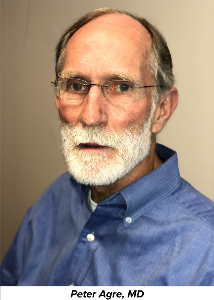 As a child, Peter Agre, MD, dreamed of being a physician, traveling the world to “serve humanity” by healing the sick.
As a child, Peter Agre, MD, dreamed of being a physician, traveling the world to “serve humanity” by healing the sick.
Instead, Agre found himself, with the support of mentor Bill Guggino, PhD, tinkering in a lab with cells, trying to figure out how water passed in and out of them. Still, that desire to serve the bigger world lingered. He loved the science, he says, but
he never had any illusion that he’d be in the lab his whole life.
“I had expected that some time in my mid-50s or sooner, I’d turn into a director—that is, not strictly a lab researcher,” says Agre, director of Johns Hopkins Malaria Research Institute and Bloomberg Distinguished Professor in
the School of Public Health. “I’m interested in science and politics, science and human rights, science diplomacy.”
Those goals are worthy. But “how do you pay your rent?” he asked.
The answer came in 2003, when the Nobel committee recognized his work identifying the “plumbing system of the cells,” the aquaporin water channels. Suddenly, Agre had the momentum to follow his extracurricular interests.
Like other Nobel winners, Agre says the immediate aftermath of the announcement was a whirlwind. By the time it settled down a year later, the pieces of his life settled in a very different arrangement.
First, he reduced the size of his lab and became the “director and cheerleader” for science instead of an active participant, as the director of Johns Hopkins Malaria Research Institute. The institute allows him to work with Johns Hopkins
researchers in African countries.
“I loved the whole idea of going to Africa and visiting our personnel there and seeing the field,” he says.
Then, he accepted membership in the Committee on Human Rights at the National Academy of Sciences, Engineering and Medicine, eventually serving as its chair. There, he petitions governments to protect or release scientists held in prison.
And he was elected president of the American Association for the Advancement of Science, where he had the chance to serve as a scientific diplomat. In that capacity, he visited countries that have been politically hostile to the U.S., such as North Korea,
Iran, Myanmar and Cuba, to foster peaceful scientific collaborations. These have included projects on improving agriculture, developing medicine and improving public health.
He found friendship with “Fidelito,” Fidel Castro’s son, who was also a scientist. Through that work, Johns Hopkins began to sponsor an outstanding Cuban chemist to come to the institution to teach. Agre doesn’t know if that program
will continue, though, as Washington policies are changing visa access for scientists.
With every trip, Agre tries to serve a greater good. He often thinks back to his Minnesota childhood, where he dreamed of serving the sick of the world. Today, he says, he’s simply grateful.
“The Nobel opened the door,” Agre says. “I have the career I imagined as a young person, just in a somewhat different form.”
And the Winner Is …
The 2019 Nobel Prize in Physiology or Medicine was awarded jointly to William G. Kaelin Jr. of the Dana-Farber Cancer Institute in Boston; Sir Peter J. Ratcliffe of the University of Oxford in England and the Francis Crick Institute in London; and Gregg
L. Semenza of Johns Hopkins University School of Medicine in Baltimore.
The three were honored for their discoveries of how cells sense and adapt to oxygen availability. In the press release accompanying the announcement, the Nobel committee explained that the researchers “identified molecular machinery that regulates
the activity of genes in response to varying levels of oxygen.” It was described as “one of life’s most essential adaptive processes.”
Though the three researchers never collaborated formally, they would discuss their latest findings with one another at scientific conferences. In a press conference at the Dana-Farber Cancer Institute, Kaelin credited this “free exchange of information”
with helping their research “hit escape velocity and go much faster.”
Two of this year’s Nobel winners—Ratcliffe and Semenza—have published frequently in APS journals. Curated lists of APS journal articles authored by Ratcliffe, Semenza and other Nobel laureates are available at www.physiology.org/nobel-laureates.
Schekman to Speak at EB 2020
Randy Schekman, PhD, will present the Nobel Prize Award Lecture at the APS annual meeting at Experimental Biology (EB) in San Diego on Tuesday, April 7, 2020. Submit your abstract today.
The Physiologist Magazine
Read the Latest Issue
Don’t miss out on the latest topics in science and research.
View the Issue Archive
Catch up on all the issues of The Physiologist Magazine.
Contact Us
For questions, comments or to share your story ideas, email us or call 301.634.7314.


